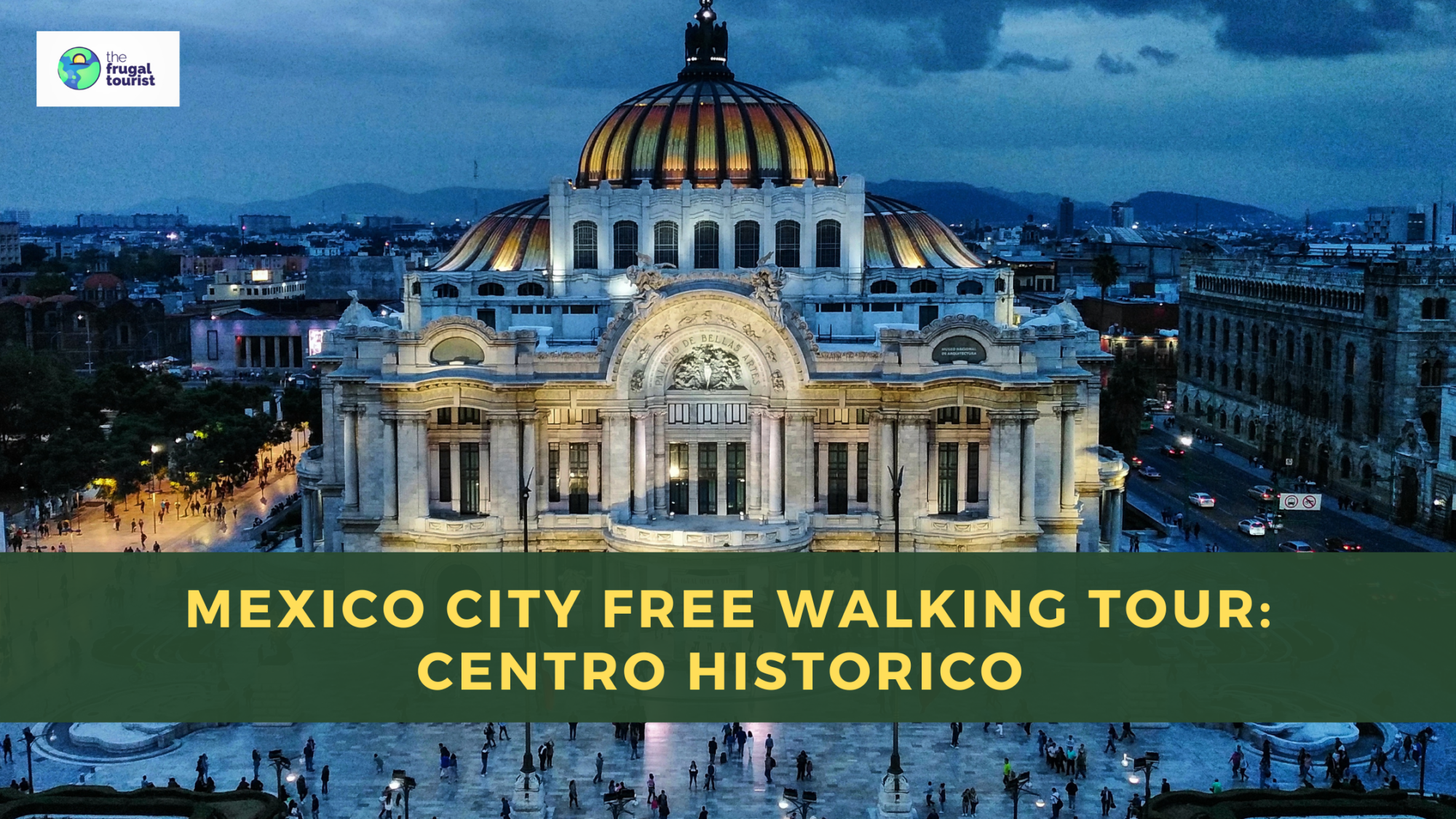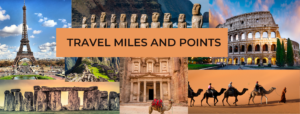ADVERTISER DISCLOSURE: The Frugal Tourist is part of an affiliate sales network and receives compensation for sending traffic to partner sites, such as MileValue.com and Cardratings. This compensation may impact how and where links appear on this site. This site does not include all financial companies or all available financial offers. Terms apply to American Express benefits and offers. Enrollment may be required for select American Express benefits and offers. Visit americanexpress.com to learn more. All information about the American Express Schwab Platinum has been collected independently by The Frugal Tourist.
EDITORIAL DISCLOSURE: Opinions, reviews, analyses & recommendations are the author’s alone and have not been reviewed, endorsed, or approved by any of these entities.
Even though Mexico City (also called CDMX: Ciudad de Mexico) is usually neglected by tourists in favor of Mexico’s more popular resort towns, it is not to be overlooked.
Despite being under the radar for decades, more and more travelers are discovering how incredible Mexico City is.
It is just a matter of time before CDMX finally receives the attention and accolades it deserves.
That said, Mexico City continues to be vastly underrated. With its countless must-see attractions, Mexico City has something to offer all types of travelers.
From contemporary arts and culture, delectable food (from street vendors to high-class dining), pre-Hispanic ruins in the heart of the city, hundreds of museums, atmospheric markets, bustling nightlife, and the gateway to one of the world’s best archaeological sites – Teotihuacan – at its doorstep, Mexico City should be on every visitor’s bucket list.

Centro Historico Mexico City Walking Tour
Being the only city in the world with over 20 million people, Mexico City can get incredibly intense and overwhelming, particularly if you only have a day or two to explore this megalopolis.
If you only have a short time in CDMX, deciding what to see or do may be quite an ordeal.
So, if you’re searching for a comprehensive Mexico City walking tour, this blog post has got you covered.
Mexico City has something for everyone. However, knowing where to start your journey on your first visit to this enormous metropolis might be daunting.
Therefore, this self-guided walking tour will take you through Mexico City’s Centro Historico, the capital’s birthplace and historic core.
Centro Historico: Must-Visit in Mexico City
Centro Historico is Mexico City’s oldest and most significant neighborhood, offering a unique perspective on its history.
It also houses the city’s greatest colonial architecture, the most important museums and art galleries, and some of Mexico City’s grandest churches.
Certainly, Centro Historico is Mexico City’s most essential sight and the ideal place to start your trip.
This self-guided walking tour connects the historic core’s most memorable sites, so you won’t have to reinvent the wheel.
Put on your walking shoes, save the free maps below on your phones, and off we go!
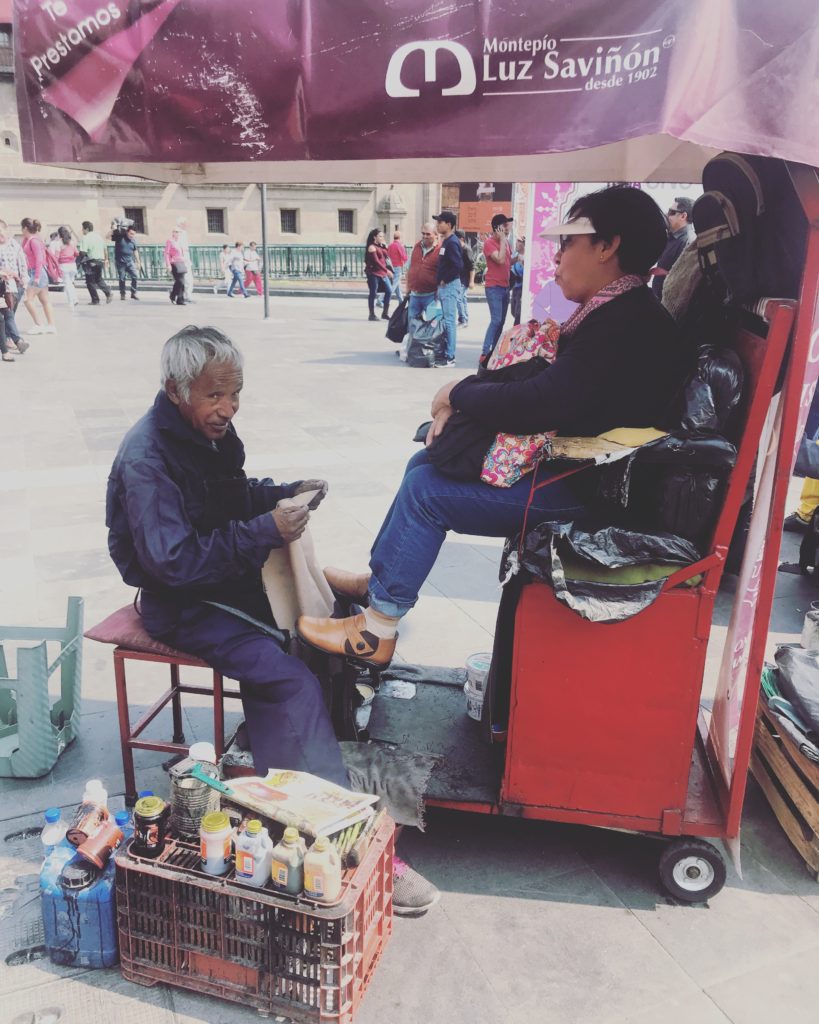
Overview: Map of the Centro Historico Walking Tour
Click this map so it opens up on your mobile phone map app.
Alternatively, you can use Google Maps to connect the destinations recommended on this tour.
Please feel free to save the maps or share them with someone who is planning to visit Mexico City in the future.
This free walking tour through Mexico City’s Centro Historico consists of three parts:
| Mexico City Self-Guided Walking Tour | |
|---|---|
| Part A | Zocalo ★ |
| Part B | Plaza De Santo Domingo to Avenida Madero (Skip with Limited Time) |
| Part C | Palacio De Bellas Artes and Alameda Central Park ★ |
Length of Tour
You will need 2-4 hours, depending on whether you linger at each site or complete this tour at a whirlwind pace.
With limited time, connect the spots with the ★ signs, as those are the unmissable major highlights.
Part A Map: Centro Historico’s Zocalo
Part A: Centro Historico’s Zocalo
A. Gran Hotel De La Ciudad De Mexico ★
How to Get Here: Uber is super affordable or for an unforgettable experience, take Mexico City’s chaotic subway. Get off at Zocalo.
We will begin our walking tour at this hotel, which features a beautiful lobby with a Tiffany-style stained-glass ceiling.
Take the elevator to the 4th floor. If it’s blocked, inform the guard that you intend to dine at the terrace restaurant, which offers the finest views of Zocalo, the heart of Mexico City.
If you haven’t had breakfast at your hotel yet, this spot is perfect for a quick refuel before embarking on your walking tour.
Opt for a table on the terrace for an unforgettable vista of Mexico City’s historic square.
After you are done with your meal or drinks, head down to the Zocalo, Mexico City’s grand square.
| Gran Hotel Fun Fact |
|---|
| The Gran Hotel Ciudad de México, a 5-star gem, is known as a “James Bond Hotel“ because it appeared in both Licence to Kill (1989) and Spectre (2015). |
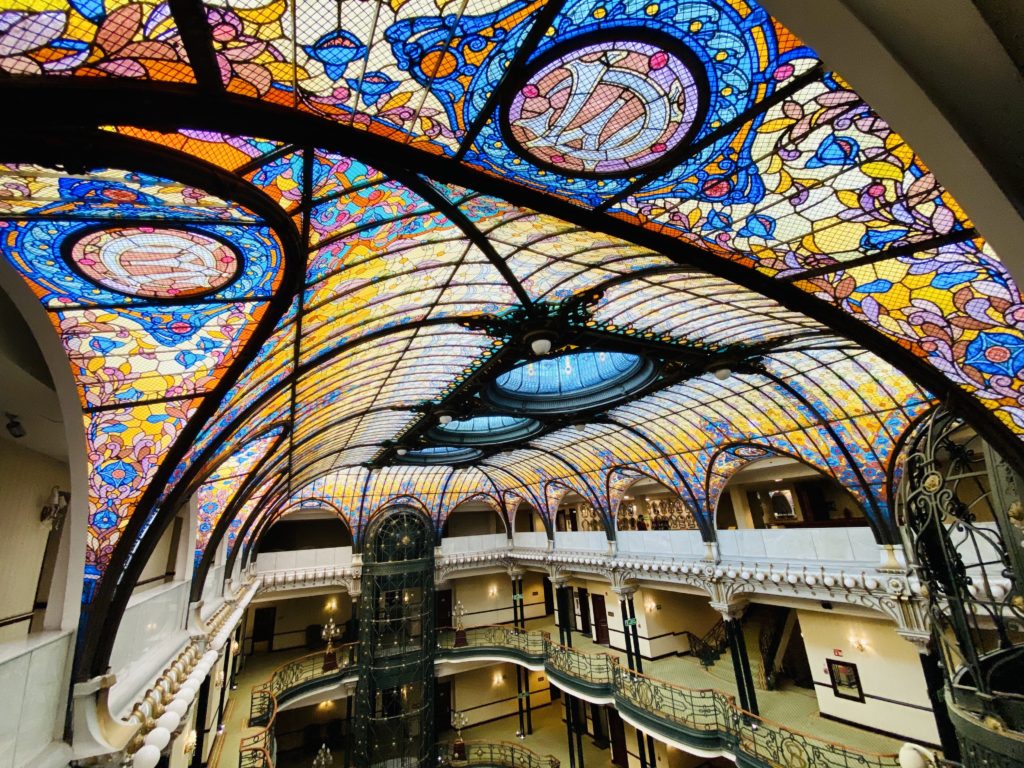
The Mexico City Metro, which opened in 1969 and has 243 stations and twelve lines, is one of the world’s longest subway systems. In fact, it is one of Mexico’s most utilized transportation systems, with around 4 million passengers daily. Taking the Mexico City Metro is a definitive CDMX experience, but it isn’t for the faint of heart. The Zocalo station is the ideal location to watch the action from a distance. Descend to the platform and be astonished by how locals pack train cars like sardines without missing a beat.
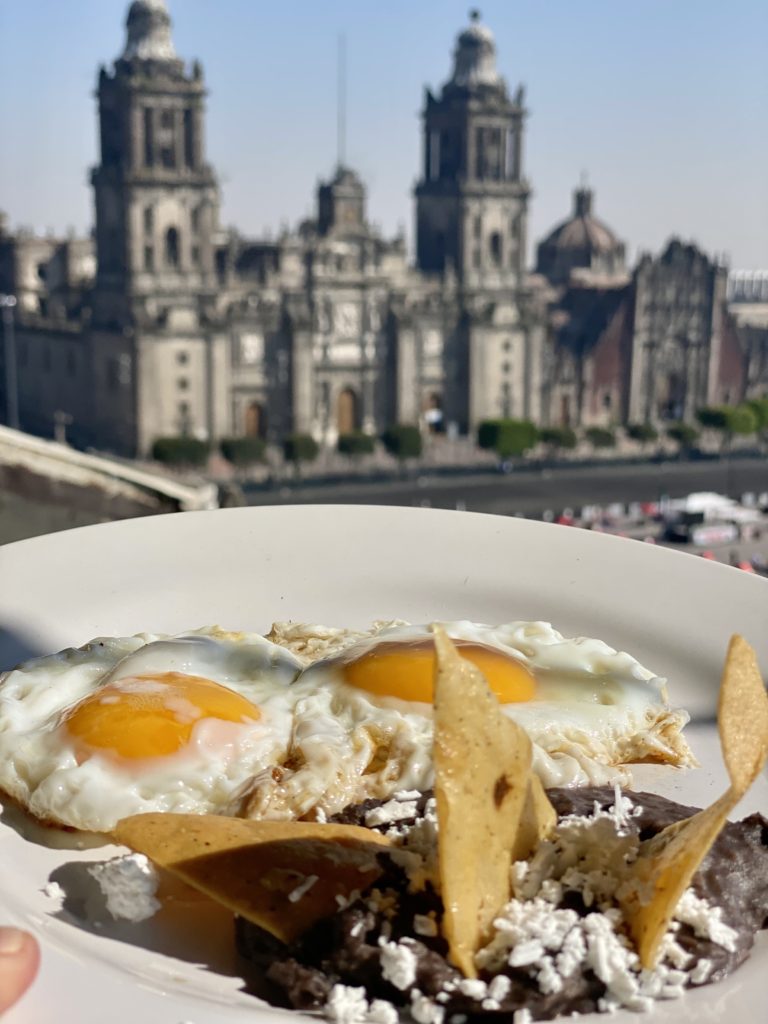
B. Zocalo ★
Mexico City’s Zocalo is the city’s vibrant core and the biggest square in Mexico City.
The name “Zocalo” actually comes from the Spanish word for “pedestal.”
Once you reach Zocalo’s center, take a full turn to absorb the breathtaking views – this is the birthplace of Mexico City.
To the east stands the Palacio Nacional, while the Cathedral graces the square’s northern edge.
Zócalo has been the heart of CDMX for centuries. It was the go-to meeting spot during the Aztec and colonial times.
It remains the only plaza in CDMX that encompasses the city’s religious, political, and commercial functions.
As you face the cathedral, walk east towards our next stop – the Presidential Palace.
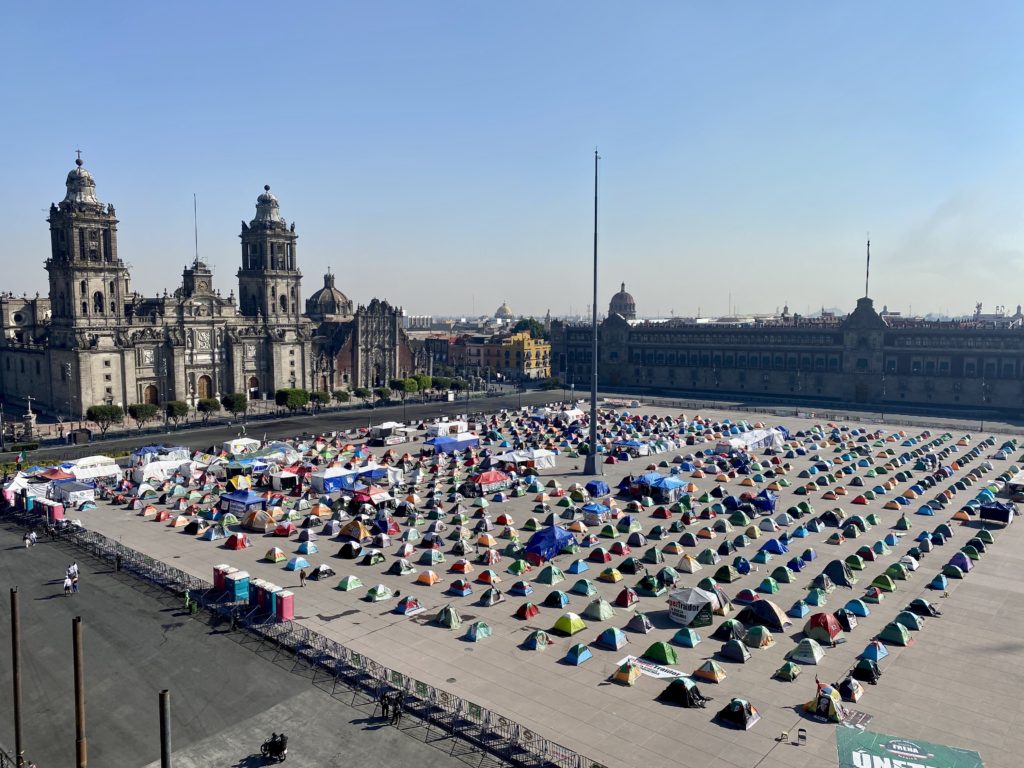
C. Palacio Nacional (Presidential Palace) ★
Palacio Nacional (Presidential Palace)
The mural is undergoing extended restoration, so we hope it will be accessible when you visit.
This massive building occupies the entire east side of Zocalo.
Walk around and ask the guards where the entrance to the complex is.
Upon entering, ask to be directed to the building that showcases the famous Diego Rivera Mural.
Once you find the mural’s location, take time to admire it.
The “Epic of the Mexican People” is one of Rivera’s magnificent masterpieces and is a must-see.
The murals, painted from 1929 to 1935, depict the Aztec way of life before the Spanish conquest.
At the top of the stairs, a mural tells the story of the Spanish conquistadors.
Look for a touching scene – a child on its mother’s back, gazing back at you.
This moving portrayal is the first of its kind. It represents a “mestizo,” symbolizing mixed heritage.
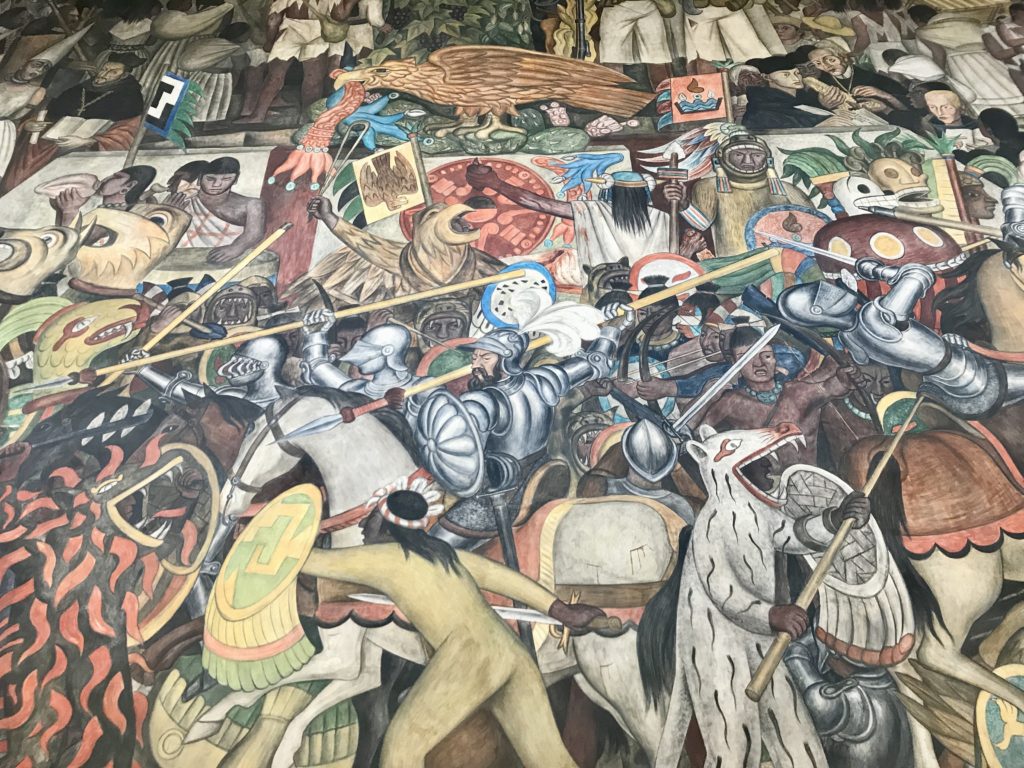
Next to Palacio Nacional is the Museo Nacional de las Culturas (National Museum of Culture), where you can learn about cultures from the past and present. It’s located in a colonial-era building that was once a mint for making coins.
| Self-Guided Walking Tour Directions |
|---|
| After your visit, exit at Calle Moneda, which is lined with stunning architectural colonial buildings: Calle Moneda #4 is the Antiguo Palacio de Arzobispado (the Catholic Bishop’s Residence during colonial times). It houses changing art exhibits. Calle Moneda #6 is the Casa de la Primera Imprenta |
| On Calle Moneda, look for the avenue “Lic. Verdad” and walk to our next stop. |
D. Ex Teresa Arte Actual -Sinking Mexico City
This 17th-century convent, now sinking, was built on an extremely unstable foundation.
Mexico City’s beginnings on a lake are especially noticeable in this old colonial building.
Currently, this convent is a museum and an arts venue.
Once you step inside, don’t forget to look up and stare at those double domes.
After trying to keep your balance in this wobbly building, head back towards Zocalo to check out Mexico’s top church – the Metropolitan Cathedral.
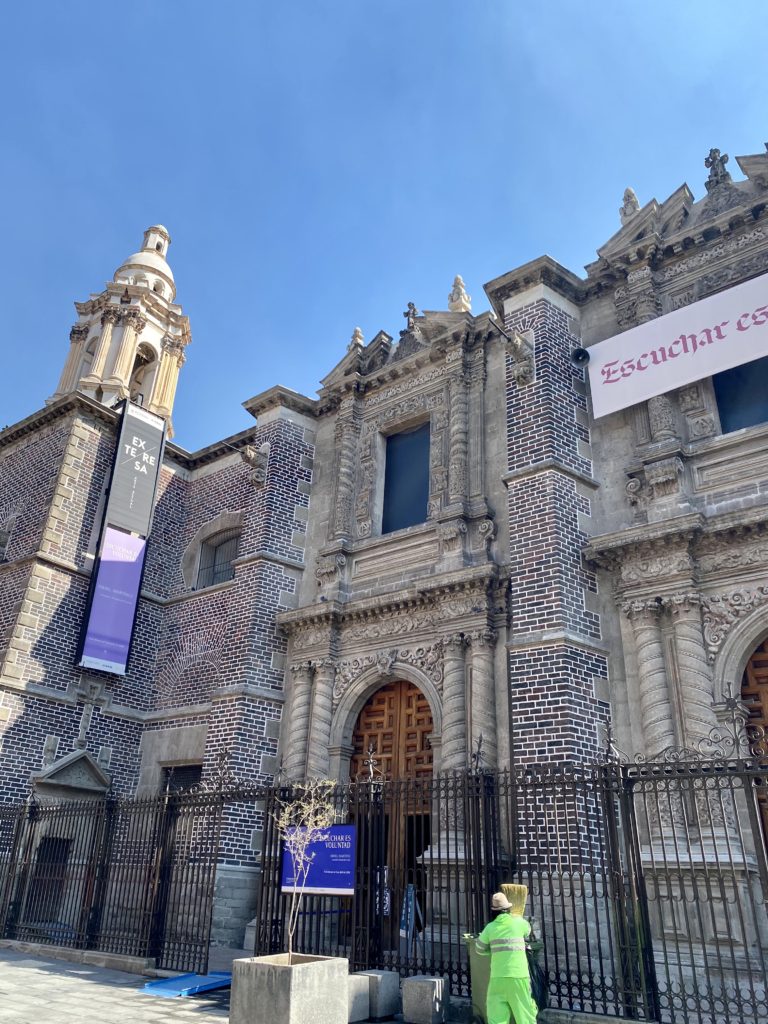
E. Mexico City Metropolitan Cathedral ★
The Metropolitan Cathedral is Mexico’s first cathedral.
Built on top of Mexico City’s Ancient Temple (Templo Mayor), the Metropolitan Cathedral is where Hernán Cortés first arrived on Mexican soil after the conquest.
Cortés played a key role in the downfall of the Aztec Empire. He is also responsible for expanding territories within modern-day Mexico under Spain’s rule in the early 16th century.
With its stunning Baroque architecture, the Cathedral wows visitors with its lavish gold display. Make sure you check out the beautifully crafted altar.
Attached to the Cathedral is the Sacristy, a smaller building added around 200 years later.
For a memorable experience, take a private tour to climb the cathedral’s rooftop domes and bell towers, offered every 20 minutes.
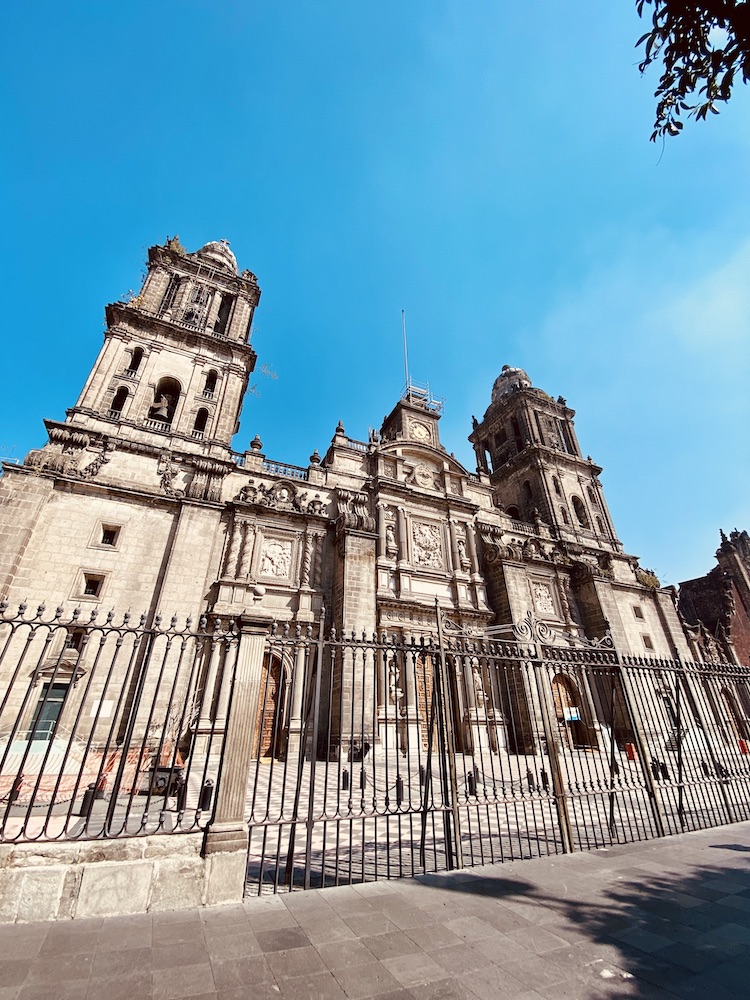
F. Templo Mayor – Main Aztec Site of Worship ★
Templo Mayor’s evocative ruins, located north of the Metropolitano Cathedral, are a must-visit in Mexico City.
Only in Mexico City can you find an ancient ruin smacked in the middle of downtown.
UNESCO designated Templo Mayor a World Heritage Site in 1987, making it Mexico City’s first UNESCO World Heritage Site.
This incredible archaeological site, discovered by chance in 1978 while electricians were installing new cables, has a museum you can visit for a fee.

As you approach the site, pay attention to rhythmic drumbeats as they signal the presence of concheros, descendants of the Aztecs, adorned in traditional garb.
Witnessing their dance, chants, and wafting incense is an unforgettable highlight in CDMX.
After touring the site, venture to the street just behind the Cathedral known as Republica de Guatemala. Locate the passageway at #10 (Pasaje Catedral).
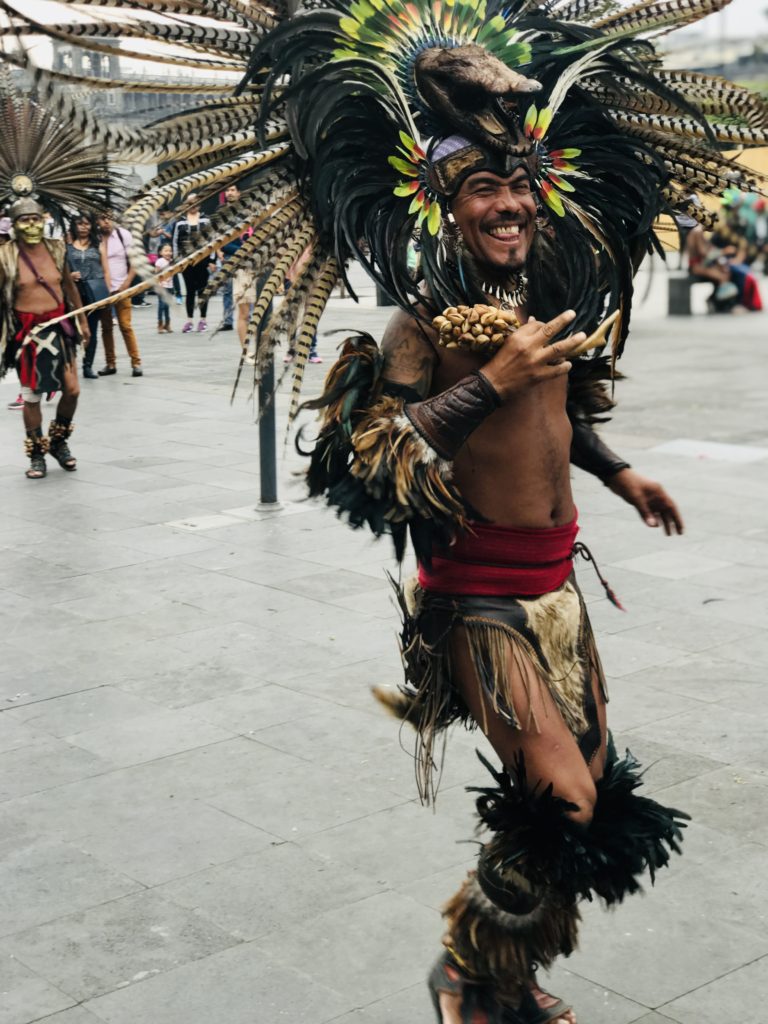
G. #10 Republica De Guatemala (Pasaje Catedral)
Check out this busy walkway filled with shops selling replicas of saints, religious items, and herbal remedies.
Take a stroll through this “pasaje” and then head out to Calle Donceles to carry on with the next part of your walking tour.
| Walking Tour Tip |
|---|
| If you have limited time, skip Part B and walk straight to Palacio de Bellas Artes by taking the pedestrianized Avenida Madero. |
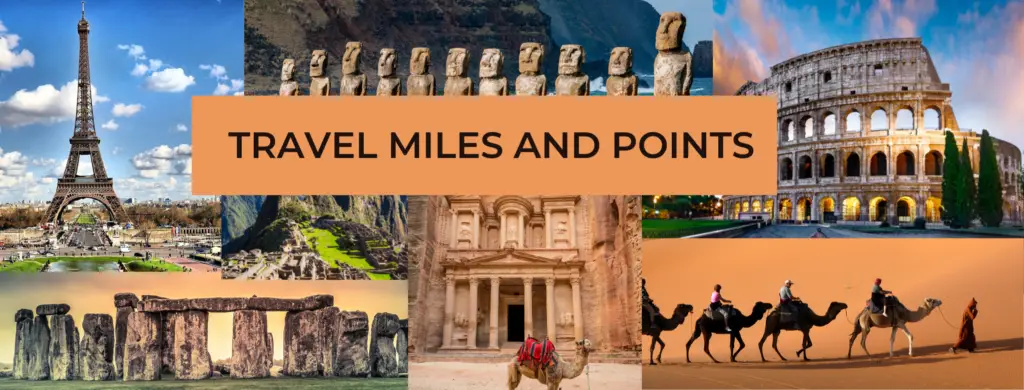
Part B Map: Plaza De Santo Domingo to Avenida Madero
The second part of this walk bridges Part A and Part C through one of Mexico City’s most popular pedestrianized avenues – Avenida Madero.
If you are pressed for time, you can skip the stops in Part B and head straight for Palacio de Bellas Artes.
Part B: Plaza De Santo Domingo to Avenida Madero
A. #10 Republica De Guatemala Passageway
Continuing from where we left off at Part A, walk down Pasaje Catedral until you reach Calle Donceles.
Safely cross to the other side and turn right. A short stroll will bring you to the charming Templo De La Ensenanza, a gem showcasing exquisite Baroque architecture.
Keep walking along Donceles until you reach Calle Republica de Argentina.
Cross the street carefully and proceed on Donceles until you reach Museo De San Ildefonso.
There, marvel at extraordinary masterpieces created by celebrated Mexican Muralists.
B. Museo De San Ildefonso
Formerly a Jesuit boarding school until 1978, Museo San Ildefonso is now a museum featuring Mexican muralists.
Explore the masterful artworks by Mexican legends at your own pace.
Afterward, backtrack along Donceles for two blocks until you reach Republica De Brazil.
Take a right turn. One block ahead, you’ll find Plaza De Santo Domingo.
C. Santo Domingo Church and Plaza
Plaza:
On the west side of the square stands the Portal de Evangelistas, a colonnade with round arches.
In this corridor, scribes with typewriters and vintage printing equipment offer their services to illiterate customers.

Fountain:
In the middle of the square stands a monument to Josefa Ortiz de Dominguez, a Mexican War of Independence heroine.
Church:
The present church is the third one constructed on this site. It boasts Baroque architecture with lovely pink granite accents.
Construction began in 1717 and was completed by 1736. Inside, you’ll find Francisco Vázquez de Coronado, the notable conquistador and explorer.
Vázquez de Coronado is famous for his expedition into what is now known as the Southwestern United States in pursuit of riches.
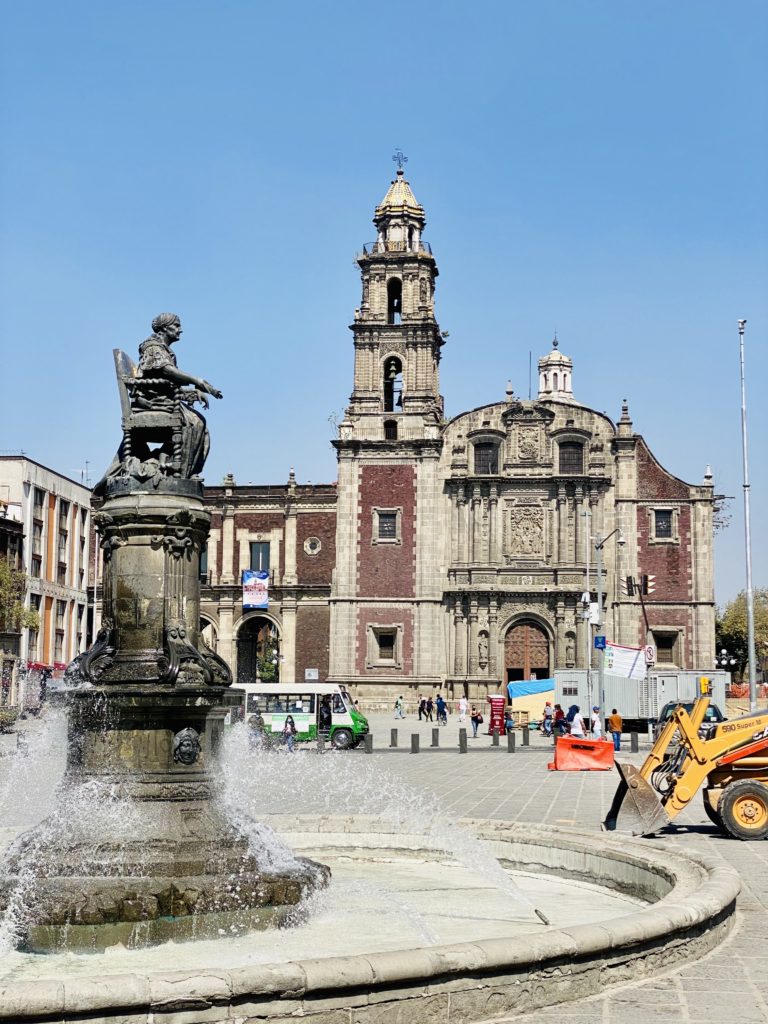
D. Antiguo Palacio De Inquisition / Palacio De La Escuela De Medicina
Across the street from Santo Domingo Church is the Antiguo Palacio de la Santa Inquisición / Palacio De La Escuela De Medicina.
Explore this grand palace featuring historical medical artifacts – a must-visit for history and medicine enthusiasts.
Once a stronghold of the Inquisition, this place was converted into a medical school.
Today, it’s home to a museum that tells Mexico’s medical history from ancient times to the 20th century.
Check out fascinating displays of human fetuses, anomalies, traditional remedies, medical artworks, and preserved medical school facilities from the past.
Entry is free for all.
After checking out this museum, walk back towards the direction of Zocalo to the next block for our next stop.
E. Secretaria de Educación Publica ★
Right across from the Plaza Santo Domingo, on Republica De Brazil #31, near the corner with Luiz Gonzalez Obregon Avenue, is the Ministry of Public Education building, Secretaria de Educacion Publico (SEP).
This government agency is now located in the historic Convent of Our Lady of the Incarnation, built in 1639 during Mexico’s time as part of the Viceroyalty of New Spain.
Within this historical building are Diego Rivera’s most esteemed murals.
For the freshest pieces, begin your journey on the 3rd floor, then gradually descend.
His artwork exuberantly portrays Mexico’s vibrant festivals, industries, and populace across more than 100 panels.
Some murals vividly depict bustling urban markets, teeming with life that almost leaps from the canvas.
The murals have been in restoration for quite some time and are slated to open in November 2024.
Now, let’s walk back towards Zocalo for several blocks and make a right on Avenida Madero.
F. Avenida Madero
Take in the many architectural styles along this busy pedestrianized street named after the former president, Francisco Madero.
Walk two blocks and make a left at Isabel La Catolica.
Pause near the corner to enter our next stop.
Francisco Madero was a Mexican business magnate, landowner, reformist, author, and statesman who served as the 37th president of Mexico from 1911. As a member of a prosperous and powerful property-owning family, he was a supporter of social equality and democracy despite his wealth. In 1910, Madero challenged longtime President Porfirio Díaz for the presidency and helped to start the Mexican Revolution. In February 1913, Mexico’s military staged a coup in the capital. Madero was arrested soon after and subsequently murdered, along with his vice-president, José María Pino Suárez. This event is now called the “Ten Tragic Days”.
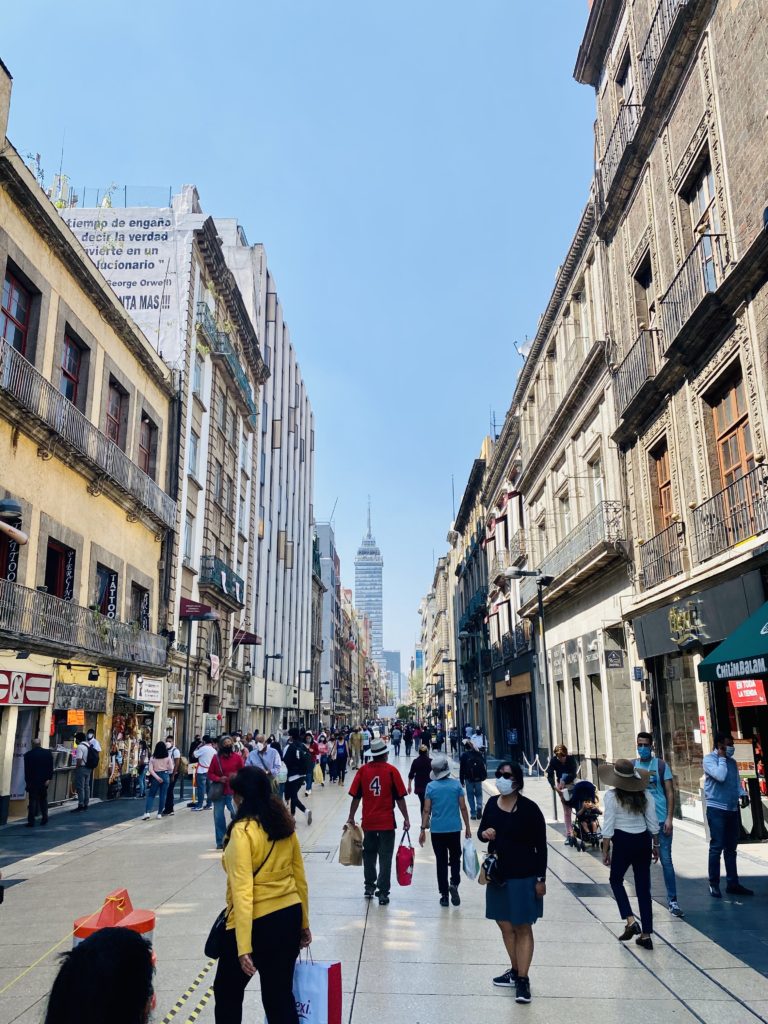
G. Museo Del Estanquillo
Located at Isabel La Católica 26, near the intersection of Avenida Maduro, this charming museum showcases CDMX’s history with photos, paintings, and movie posters. Entry is free!
A highlight of this museum is its rooftop café, offering a terrace with breathtaking views.
After your visit, return to Avenida Maduro and continue down the street for two and a half blocks.
Pause when you reach Avenida Maduro #17 for our next stop.
H. Palacio de Iturbide
Constructed in 1780, this Baroque building from the 18th century has served various purposes over the years – such as a palace, a school, a hotel, and a venue for cultural events.
Once home to General Iturbide, a respected hero of Mexican independence and the first president, this place also features a beautiful chapel on the right side as you go up the stairs.
In 1972, it got a name makeover and became the Palacio de Cultura Banamex (Citibanamex Culture Palace).
Continue your trek down Avenida Maduro for one and a half blocks to our next must-see stop.
I. Casa de los Azulejos (The House of Tiles) ★
Explore this former 18th-century Baroque Palace and admire the striking blue and white Puebla tiles gracing its three sides.
The windows, balconies, and doors are decked out with carved stone and elegant French porcelain crowns, giving off a vibe of luxury.
Head upstairs to check out the detailed tile work up close, especially the amazing ceiling above the staircase.
Explore the charming Sanborns restaurants with a Moorish courtyard and fountain.
Be sure to see the 1925 Orozco mural “Omniscience” near the entrance to the restaurant staircase. It shows figures representing both masculine and feminine qualities.
Right across from the House of Tiles is our next stop – Templo De San Francisco
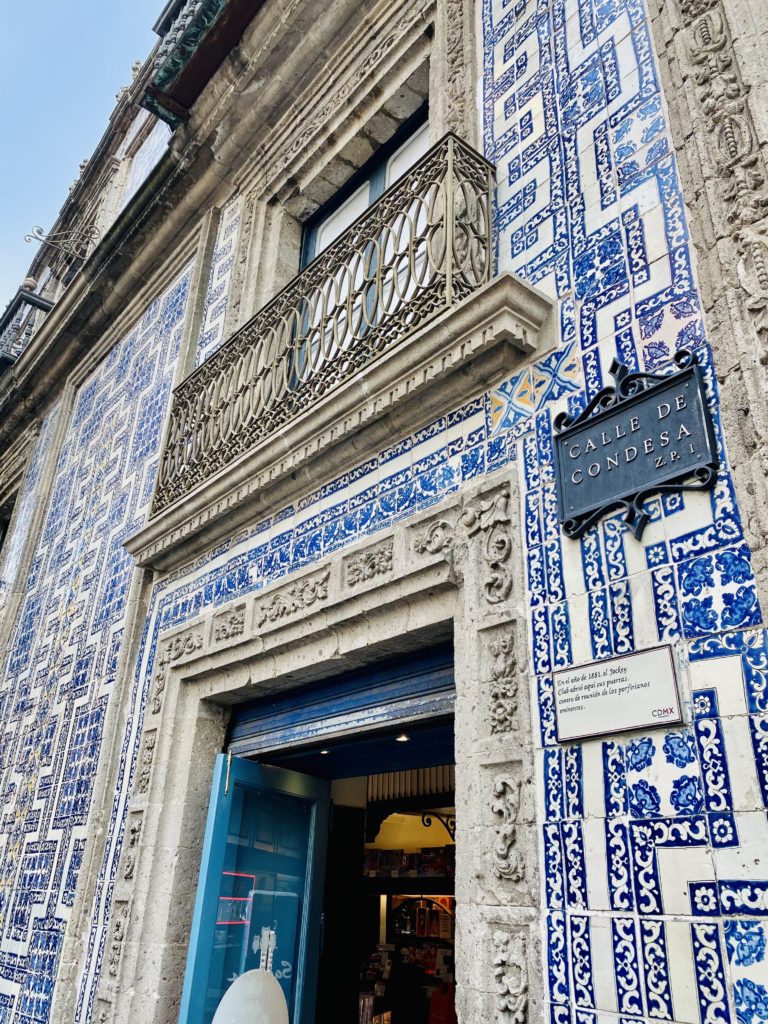
J. Templo de San Francisco
This church has a baroque exterior with a fancy carved facade.
It’s another old sinking building, a nod to Mexico City’s watery history.
You can also see Casa de los Azulejos from here.
And right nearby is Atrio de San Francisco, where they often have cool art shows.
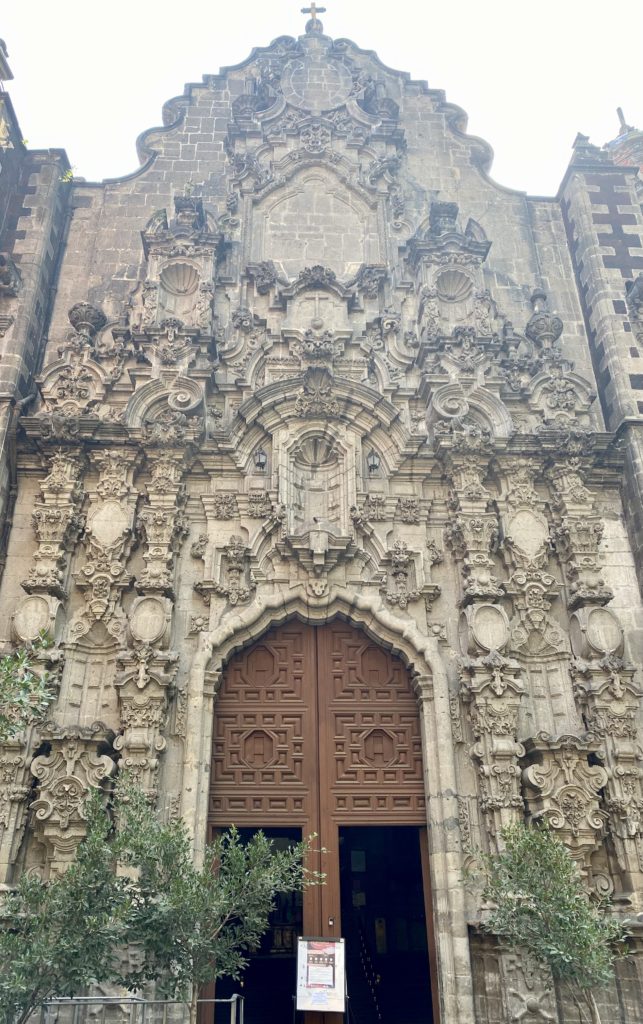
Part C Map: Palacio Bellas Artes and Alameda Central Park
Part C: Palacio Bellas Artes and Alameda Central Park
A. Templo De San Francisco
We’ll pick up where we left off from Part B.
Just a few meters away from Templo De San Francisco is Torre Latinoamericana.
You can’t miss this skyscraper – it’s one of the tallest in Mexico City. The entrance is on Eje Central Lazaro Cardenas.
B. Torre Latinoamericana
At 166 meters tall, this building is a standout in a seismic hotspot.
Known worldwide for its exceptional engineering, it bravely survived the 1985 Mexico City earthquake unscathed, unlike many others.
For almost 27 years, the Torre Latinoamericana was Mexico’s tallest building until the Ejecutiva Pemex Tower took over in 1982.
On the 38th floor, you’ll find a photo exhibit on its construction. The 41st floor is home to a cool bar and restaurant, and the 44th floor offers panoramic views of CDMX, including Palacios Bellas Artes and Alameda Central Park.
When you are ready to return to the tour, go down the main avenue and walk two blocks north towards Calle de Tacuba, then make a right to find our next stop.
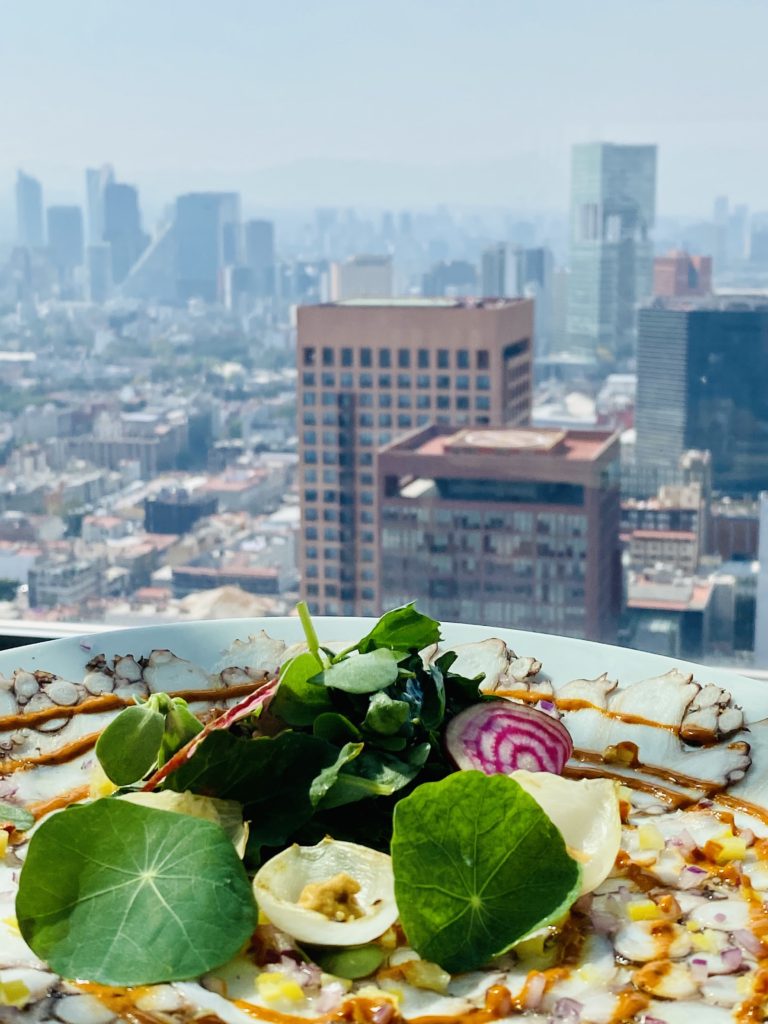
C. Plaza Manuel Tolsa
This plaza, with its grand neoclassical buildings, gives off major European vibes.
The equestrian statue of Charles IV of Spain, known as El Caballito, was made by Manuel Tolsá between 1796 and 1803 in Mexico City to honor King Charles IV of Spain, the final ruler of New Spain (now Mexico).
It’s one of Tolsá’s top works and has been displayed in different spots across the city.
Palacio De Mineria
The Palace of Mining, or the Palace of Mines (Palacio de Minería in Spanish), is considered one of North America’s finest neoclassical architectural gems.
Manuel Tolsa designed and completed it between 1797 and 1813.
Museo De Nacional De Artes
Constructed in 1905, this spot now holds an awesome collection of Mexican art. Swing by the museum to see the cool cast iron staircase.
Walk toward Eje Central and look for the Central Post Office (Palacio Postal).
D. Palacio Postal / Palacio de Correos de Mexico
This building went up in 1907 when the Postal Service became official.
Changes were made in the ’50s, leading to damage during the ’85 earthquake in Mexico City.
Restoration work brought it back to its former glory by the ’90s.
Ride the elevator up, then take the stairs down to soak in its beauty.
Safely cross Eje Central to our next stop – a must-see!
E. Palacio de Bellas Artes ★
The Palacio de Bellas Artes is a stunning cultural spot located on the western side of the historic center, right by the lovely Alameda Central Park.
Built back in 1904 with a splash of French Belle Epoque style, the place has a mix of Art Nouveau and Neoclassical vibes on the outside. Step inside, and you’ll see lots of Art Deco design elements.
Known as Mexico’s “Cathedral of Art,” it hosts awesome music, dance, theater, opera, and literature events. Locals call it the “Giant Wedding Cake” because of its appearance.
The main front and the inside are all decked out in white Italian Carrara marble.
In the middle of the building, you’ll find a breathtaking crystal roof created by Hungarian Géza Maróti, showcasing Apollo and the muses.
The walls on each floor are adorned with murals by Mexico’s top muralists. Plus, a Tiffany glass stage curtain and a glass dome add to the interior charm.
Be sure not to miss the dark bronze statues in the plaza outside, known as Los Pegasos, with their flying horses and joyful human figures.
These horses used to be at the Zocalo and now have found a new home here.
Once you’re done exploring, head to the Sears building across the street for one of the best views of Bellas Artes.

F. Sears (Cafeteria Terraza) ★
This cozy coffee joint sits up on the 8th floor of the Sears Department Store.
The view is absolutely stunning, and the coffee is top-notch.
While they don’t have a huge food selection, that’s really not why you’re here.
Grab a seat on the terrace for some awesome views of Palacio de Bellas Artes.
It can get pretty busy later in the day, so swing by early and skip the weekends to dodge the crowds.
From the Sears Coffee Shop, walk through the Alameda Central Park for our next stop – Plaza Santa Vera Cruz
G. Plaza Santa Vera Cruz
Plaza de Santa Veracruz, near Alameda Central Park, used to be the atrium of Santa Veracruz church.
It’s a favorite spot in Mexico City for its calm atmosphere. Today, it’s a hub for booklovers who trade books online.
Flanked by two churches and museums, this plaza reflects Mexico City’s sinking colonial buildings.
Santa Vera Cruz Monastery
This church, one of the oldest in Mexico City, was built in 1586 and reconstructed in the 18th century.
Despite losing many interior decorations, it holds two significant images: the Christ of the Seven Veils and the Virgin of the Remedies.
Damaged by the 2017 earthquake and fires in 2020, it’s now unsafe to enter.
Manuel Tolosa, an architect of Mexico City’s renowned structures, was buried here after he died in 1816.
Church of San Juan de Dios
Up north from this friendly square lies the Hospital de Los Desamparados chapel, which has been managed by the Order of San Juan de Dios monks since 1604.
Museo Franz Mayer
The museum, set up in ’86, showcases and conserves Latin America’s vast décor collection.
Located in a renovated 16th-century building, it was created by Franz Mayer, a stockbroker who spent fifty years gathering artworks, books, furniture, ceramics, textiles, and decorative pieces.
For just five pesos, folks can step into the lovely courtyard and enjoy a cup of coffee in this peaceful spot.
Museo de la Estampa
The museum pays homage to Mexican graphic arts, specializing in seals, woodcuts, lithography, and more.
Founded in 1986, it resides in a Neoclassical building on this historic square.
Check out the map to find your way to our next spot: Museo Mural Diego Rivera, located at the western end of Alameda Central Park.
H. Museo Mural Diego Rivera ★
As of 2024, this museum only accepts cash in pesos.
This must-see museum aims to preserve and promote Diego Rivera’s artistic work, including his revolutionary mural “Sueño de una tarde dominical en la Alameda Central” (Dream of a Sunday Afternoon in the Alameda Central).
The museum was built in 1986 to showcase Rivera’s mural, which used to hang at the Hotel del Prado. It was moved after the place was damaged in the 1985 earthquake in Mexico City.
Finished in 1947, the mural features over 150 people, including big names in Mexican history, like Hernán Cortés, Benito Juárez, Maximiliano de Habsburgo, Francisco Madero, and Porfirio Díaz.
The mural’s theme was Alameda Central, right across from the hotel. In the lower right corner, spot some vendors and reformers, Frida Kahlo, other artists’ partners, and some of his kids.
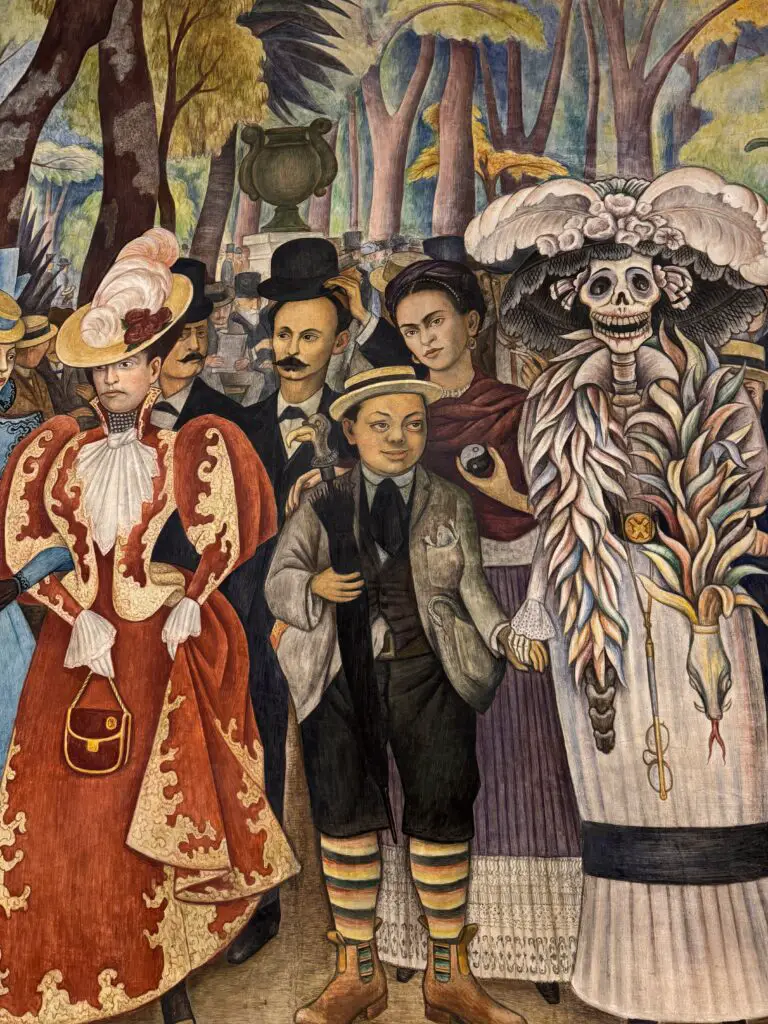
Once you are done, cross the street to our final stop – the amazing Alameda Central Park.
I. Alameda Central Park ★
Congratulations on finishing the walking tour!
The Alameda Central, the oldest public park in the Americas since 1592, has cool stone paths, fountains, and statues.
Once an Aztec market, it now features poplar trees, old-school Greco-Roman fountains, and vintage gas and electric lights.
Great for chilling and people-watching in the heart of a bustling city!
You can take an Uber to your next destination from anywhere near the park.
Alternatively, the subway can be accessed via the station at Bellas Artes.
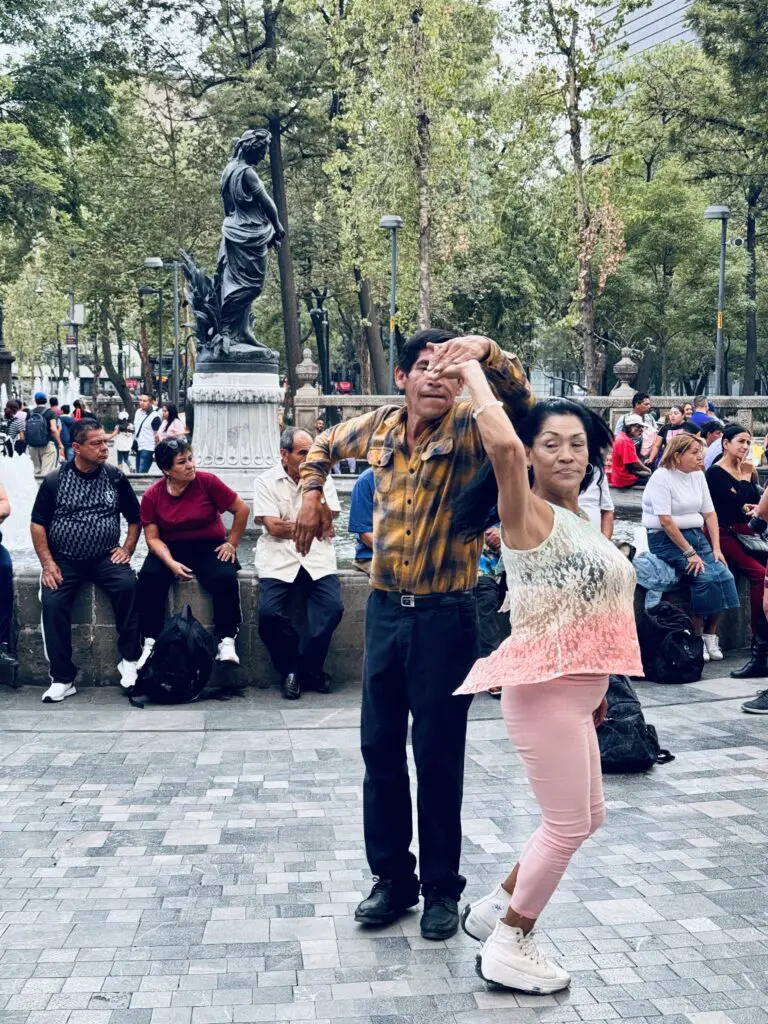
a
Where to Stay in Mexico City
For tourists, I suggest using credit card points and free night awards to save some cash when visiting Mexico City.
I recommend staying at the Andaz as it is centrally located in one of Mexico City’s exciting neighborhoods.
I stayed here for free using the World of Hyatt points I earned from my Chase Sapphire Preferred® Card and World of Hyatt Business Credit Card.
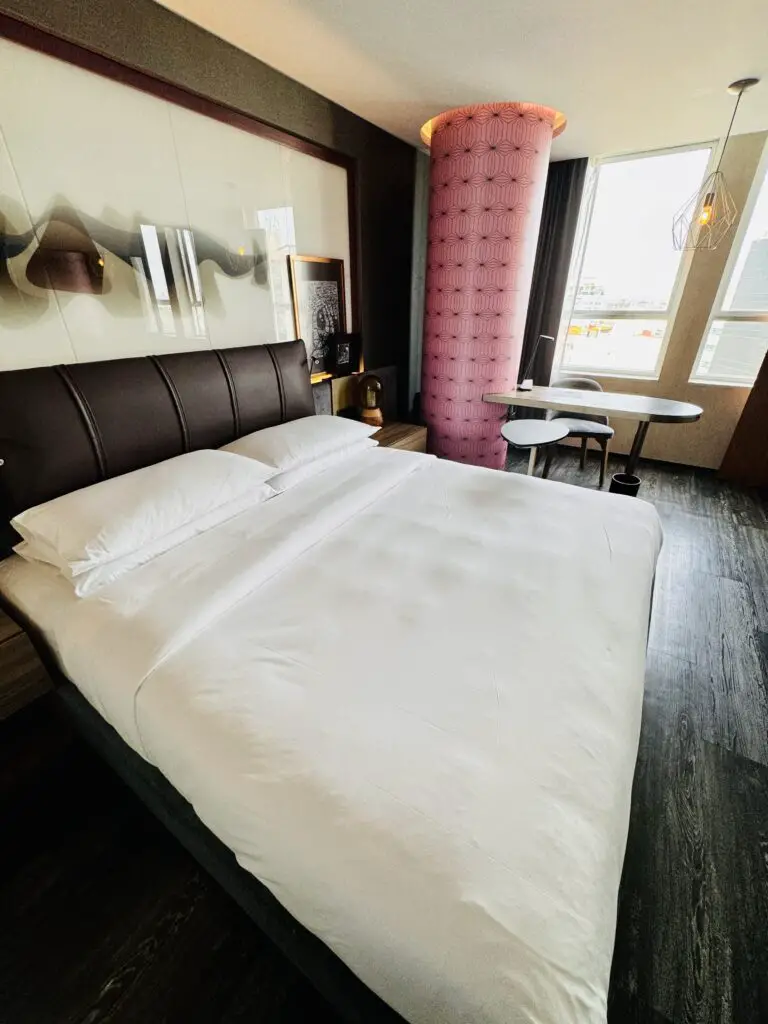
Travel Insurance
How to FLY to Mexico City for almost FREE
All of my trips over the past decade had been ALMOST FREE via travel miles and points.
I accumulate these points from credit card rewards and bonuses.
Some of these credit cards are featured here.
If you are new to traveling using miles and points, join us in our Free Travel Miles and Points Facebook Group.
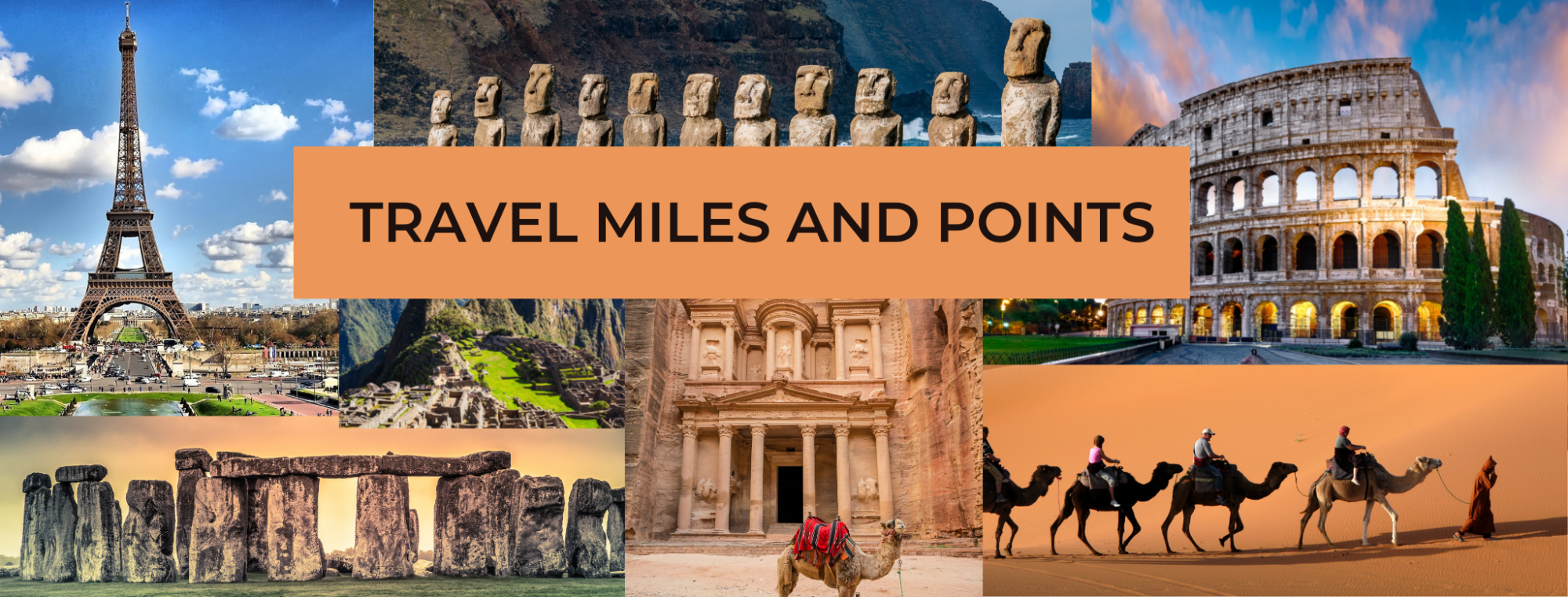
Final Thoughts
The Centro Historico is a great location to visit if you want to see some of Mexico City’s most magnificent architectural and historical monuments.
This walking tour is an excellent way to get lost in the beauty of this largely unappreciated metropolis.
Starting your trip in this lively historic core is a great idea, especially if it’s your first time in CDMX.
On this self-guided walking tour, you’ll stumble upon pre-Hispanic ruins, awesome colonial architecture, delightful churches, and lovely parks and plazas.
Plus, you’ll get to check out some of Diego Rivera’s incredible masterpieces.
I hope you find this free self-guided walking tour helpful in piecing together an unforgettable day in Mexico City’s Centro Historico.
ADVERTISER DISCLOSURE: The Frugal Tourist is part of an affiliate sales network and receives compensation for sending traffic to partner sites, such as MileValue.com and Cardratings. This compensation may impact how and where links appear on this site. This site does not include all financial companies or all available financial offers. Terms apply to American Express benefits and offers. Enrollment may be required for select American Express benefits and offers. Visit americanexpress.com to learn more. All information about the American Express Schwab Platinum has been collected independently by The Frugal Tourist.
EDITORIAL DISCLOSURE: Opinions, reviews, analyses & recommendations are the author’s alone and have not been reviewed, endorsed, or approved by any of these entities.
USER-GENERATED CONTENT DISCLOSURE: The comments section below is not provided or commissioned by the bank advertiser. Responses have not been reviewed, approved, or otherwise endorsed by the bank advertiser. It is not the bank advertiser’s responsibility to ensure all questions are answered.

